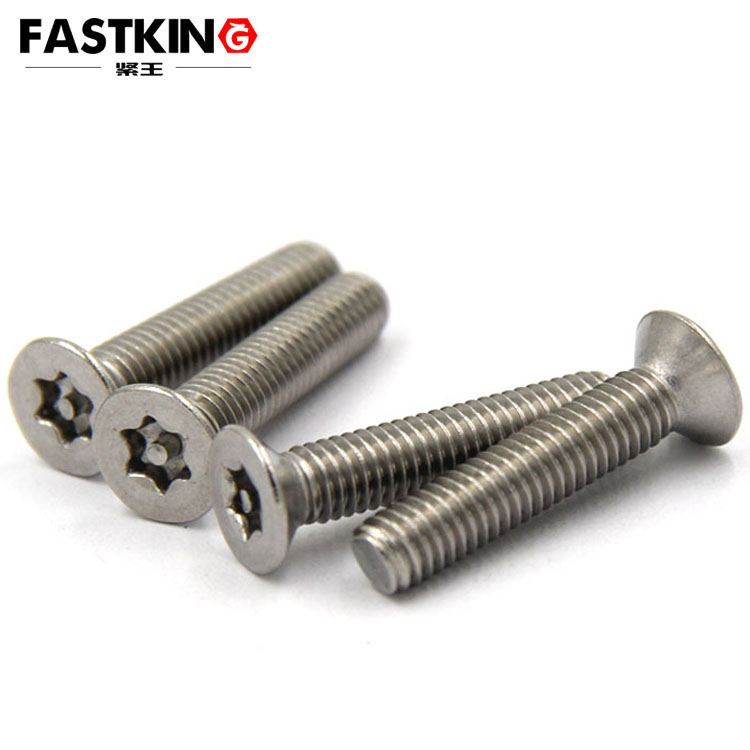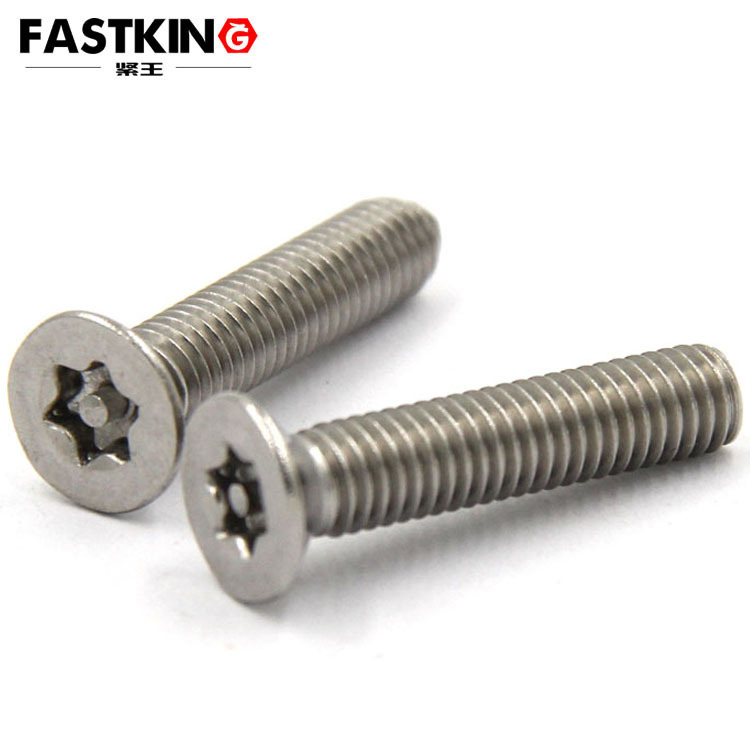- Torx screw,torx machine screw,torx self tapping screw
- sales@jlfastener.com
torx flat head machine screw with pin
Torx machine screw
torx flat head machine screw with pin
- Description:The countersunk-head inner plum blossom bolt with a post is a specialized fastener that combines the dual characteristics of "hidden fastening" and "tamper-proof and anti-theft". Its countersunk-head
I. Core Features: Clarify the "Anti-Theft Logic" for Applicable Scenarios
The core advantages of the countersunk-head inner plum blossom anti-theft bolt with post stem from its structural design. Firstly, the countersunk-head shape fits the countersunk hole of the connected part, ensuring the head is flush with the surface after installation. This avoids scratches caused by protrusions or leverage points for disassembly, making it suitable for scenarios requiring "hidden fastening" such as outdoor lamps and traffic signs. Secondly, the cylindrical post inside the inner plum blossom slot forms a "tamper-proof lock point". Ordinary inner plum blossom wrenches cannot be inserted due to the lack of a corresponding hole, and only a dedicated wrench with a positioning post can be used for operation. This can resist violent disassembly with tools like crowbars and ordinary screwdrivers, making it suitable for vandalism-prone equipment such as distribution boxes, security cameras, and subway platform screen doors.
It should be noted that the anti-theft level must match the scenario: for general civil scenarios (e.g., community fitness equipment), regular carbon steel with galvanizing treatment can meet the needs; for high-security scenarios (e.g., bank ATMs, high-voltage distribution boxes), stainless steel (304/316) with a high-strength post structure must be selected to ensure long-term anti-theft performance and rust resistance in humid and corrosive environments.
II. Selection Points: Determine Parameters Based on "Scenario Requirements"
When selecting the bolt, focus on three key dimensions—material, specification, and surface treatment—to ensure adaptation to actual working conditions:
- Material Selection: Prioritize screening based on environmental corrosion and strength requirements. For outdoor or humid scenarios (e.g., park benches, outdoor charging piles), choose 304 stainless steel to resist rain erosion; for coastal salt spray environments (e.g., port equipment, offshore traffic signs), select 316 stainless steel to enhance salt spray resistance; for dry indoor and low-load scenarios (e.g., fixing office furniture locks), carbon steel can be chosen for lower cost.
- Specification Matching: Match the thickness and hole diameter of the connected part. The countersunk-head diameter must be consistent with the countersunk hole diameter (common specifications: φ4-φ12) to avoid wobbling due to looseness or base material crushing due to over-tightening. The thread length should cover the thickness of the connected part plus 1-2 thread pitches. For example, when connecting a 5mm-thick aluminum alloy sign, a bolt with a thread length of ≥7mm is required to ensure sufficient engagement depth. The post diameter must be precisely matched with the hole of the dedicated wrench (tolerance ≤0.1mm); otherwise, it may cause wrench slipping or damage to the bolt slot.
- Surface Treatment: Balance corrosion resistance and aesthetic adaptation. For outdoor scenarios, choose hot-dip galvanizing (strong corrosion resistance) or Dacromet treatment (salt spray resistance); for high-end indoor equipment (e.g., smart home control panels), select nickel plating—its silver appearance coordinates with the equipment texture; for dark-colored equipment (e.g., black security camera housings), black zinc treatment can be used to improve overall aesthetics.
III. Installation Specifications: Avoid "Operational Errors" Affecting Anti-Theft Performance
Specialized tools and standardized procedures must be used for installation; otherwise, anti-theft failure or bolt damage may occur:
- Tool Preparation: A dedicated inner plum blossom wrench with a post of the corresponding model must be used (confirm that the positioning post diameter of the wrench matches the bolt post). Using ordinary inner plum blossom wrenches or modified tools for forced disassembly is prohibited, as this may damage the post structure and lose the anti-theft function.
- Base Material Preparation: The connected part must be pre-processed with a matching countersunk hole (countersunk hole depth = bolt head thickness + 0.2-0.3mm) to ensure the head is flush after installation. For soft base materials such as wood and plastic, pre-drilling and tapping are required to avoid base material cracking or thread stripping caused by direct screwing.
- Installation Operation: Insert the bolt into the countersunk hole, and apply vertical torque with the dedicated wrench. The torque value should refer to the material specification (e.g., recommended torque for M5 stainless steel bolts: 3-5N・m) to avoid looseness due to insufficient torque or head breakage due to excessive torque. After installation, check if the head is flush with the base material surface (no protrusions or depressions) to ensure a flat appearance and no leverage points for disassembly.
IV. Typical Scenario Applications: Targeted Adaptation Solutions
Different scenarios have distinct requirements for anti-theft performance and fastening, so adaptation solutions must be formulated based on actual working conditions:
-
Public Facilities Field: Fixing outdoor lamps and traffic signals requires both anti-theft performance and weather resistance. Select M6×12 countersunk-head inner plum blossom anti-theft bolts with post made of 304 stainless steel, with hot-dip galvanizing treatment to resist rain. During installation, ensure the bolt head is flush with the lamp housing to avoid hooking by pedestrians or objects. Meanwhile, the dedicated wrench should be kept only by maintenance personnel to prevent unauthorized disassembly that may cause equipment damage or theft.

- Security Equipment Field: Fixing surveillance cameras and access controllers requires high anti-theft levels. Choose M5×8 bolts made of 316 stainless steel, with nickel plating to match the silver equipment housing. When installing on walls or metal brackets, ensure the threads are fully engaged with the bracket (engagement depth ≥5mm) to prevent bolt falling due to violent prying and ensure long-term stable operation of the equipment.
- High-End Equipment Field: Fixing smart home control panels and internal components of ATMs requires both aesthetics and anti-theft performance. Select M4×6 carbon steel bolts with nickel plating; the countersunk-head design ensures a flat panel surface, and the post structure prevents users from disassembling the panel by themselves (which may damage internal circuits). During installation, use anti-slip washers to enhance fastening stability in vibrating environments and avoid bolt looseness during equipment operation.
V. Maintenance and Replacement: Ensure Long-Term Anti-Theft Performance
Regular inspections are required for daily maintenance, and dedicated procedures must be followed for replacement:
- Regular Inspections: Conduct inspections every 3-6 months, focusing on checking for prying marks on the bolt head and surface rust. If damage to the post structure or thread looseness is found, replace the bolt promptly to avoid anti-theft failure. For outdoor scenarios, increase inspection frequency after rainy seasons or salt spray periods.
- Replacement Procedures: When replacing, use the dedicated wrench of the original model for disassembly; violent damage is prohibited. The new bolt must match the original specifications (material, specification, and post diameter), and the standardized installation procedure should be repeated to ensure the anti-theft function of the new bolt is normal.
The core of applying countersunk-head inner plum blossom anti-theft bolts with post lies in "structural adaptation to scenarios and compliance with standardized operations". Through precise selection, standardized installation, and regular maintenance, their dual advantages of anti-theft performance and flat fastening can be fully utilized, providing reliable security guarantees for various scenarios and avoiding property losses or equipment failures caused by improper fastener selection.


